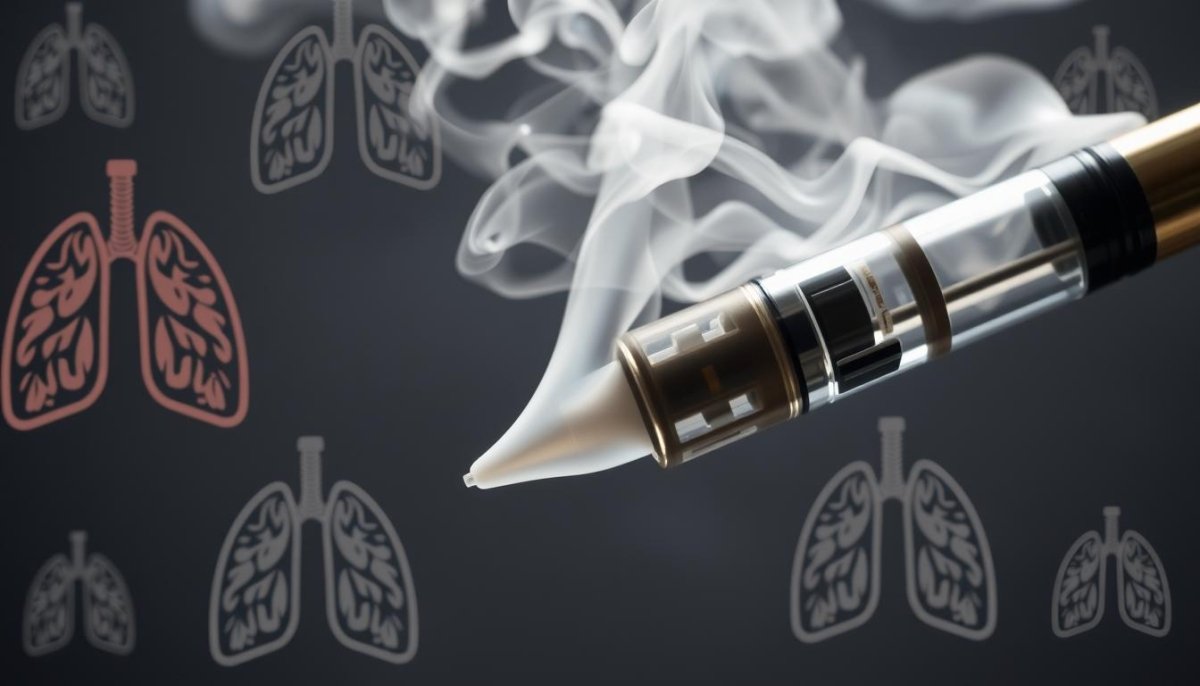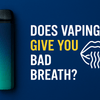Vaping and Lung Health: What You Need to Know Today

Vaping and Lung Health: What You Need to Know Today
Vaping has become more popular, raising worries about its effect on lung health. Rebecca, a 29-year-old from London, switched to e-cigarettes to feel better. "I thought vaping was healthier," she says. "But after a few months, I had a cough and trouble breathing, which scared me."
Rebecca's story shows the complex link between vaping and lung health. In this article, we'll look at the latest science, expert views, and personal stories. We aim to understand this important health issue better.
Key Takeaways
- Vaping is seen as a safer option than smoking, but its long-term lung health effects are still unclear.
- E-cigarettes contain harmful chemicals like nicotine, flavourings, and propellants when inhaled.
- While vaping might be safer than smoking, it's not completely safe. There are concerns about its impact on young people's lungs.
- Experts suggest weighing vaping's risks and benefits. They also recommend quitting if you're addicted to nicotine.
- Research and health initiatives are ongoing to understand vaping's long-term effects. They aim to create policies that protect public health.
Understanding Vaping: The Basics of E-Cigarettes
Vaping, or using electronic cigarettes (e-cigarettes), has become more popular as a tobacco alternative. It's important to understand the basics and how it works.
What is Vaping?
Vaping means inhaling and exhaling a vapour from an electronic device. These devices, called e-cigarettes, aim to mimic smoking without tobacco. They use a battery to heat a liquid solution, which includes nicotine and flavourings.
How Do E-Cigarettes Work?
E-cigarettes have a battery, a heating element, and a tank for the liquid. When you use it, the battery heats the liquid, turning it into vapour. This vapour is inhaled, giving a nicotine hit similar to smoking.
E-cigarettes come in many styles and flavours, making them appealing to many. This variety has made vaping popular, especially for those looking for a smoking alternative.
The Composition of E-Liquids: What You Inhale
Vaping involves using e-liquids, which are heated and inhaled. These liquids have various ingredients that can affect your health. Let's explore the common ingredients in e-liquids and the role of nicotine in vaping.
Common Ingredients in E-Liquids
E-liquids mainly contain propylene glycol and vegetable glycerin. These help create the vapour. They also have flavourings, from fruits to desserts, to match different tastes.
Other ingredients include:
- Nicotine (in varying concentrations)
- Distilled water
- Food-grade colourings
- Sweeteners
The Role of Nicotine
Nicotine, found in traditional cigarettes, is also in e-liquids. The nicotine levels vary, from none to high. Nicotine can increase heart rate and blood pressure.
E-cigarettes might help those trying to cut down on nicotine. But, it's key to know the long-term effects of vaping nicotine. Always talk to a doctor before starting.
Knowing what's in e-liquids is crucial for safe vaping. Being aware of ingredients and nicotine helps vapers make better choices for their health.
Vaping vs. Smoking: A Comparative Analysis
Vaping has become more popular, but it's important to know how it differs from smoking. We need to understand the health risks of each. This helps us make better choices for our health.
Health Risks of Traditional Cigarettes
Smoking cigarettes is a big risk for serious health problems. Cigarette smoke has over 7,000 chemicals, many of which are harmful. These can cause lung cancer, heart disease, and stroke, among other serious illnesses.
How Vaping Differs from Smoking
E-cigarettes don't burn tobacco like regular cigarettes do. They use a battery to heat up a liquid solution. This solution usually has nicotine, propylene glycol, and flavourings. It's seen as a safer option because it doesn't involve burning tobacco.
| Characteristic | Traditional Cigarettes | E-Cigarettes (Vaping) |
|---|---|---|
| Mechanism | Combustion of tobacco | Vaporisation of e-liquid |
| Chemicals | Over 7,000 chemicals, including carcinogens | Primarily nicotine, propylene glycol, and flavourings |
| Health Risks | Well-established as a major cause of lung cancer, heart disease, and stroke | Potential risks still under investigation, but generally considered less harmful than traditional smoking |
Vaping might be safer than smoking, but it's not without risks. The long-term effects of vaping are still being studied. It's important to remember that vaping is not completely safe.
The Impact of Vaping on Lung Health
Vaping is becoming more popular, and research is uncovering its effects on lung health. Vaping can harm the lungs in both short and long terms. It's crucial to understand this growing health concern.
Short-term Effects on Respiratory Function
Research shows vaping can harm breathing right away. The chemicals in e-cigarettes can irritate and inflame the lungs. This can cause coughing, wheezing, and breathing difficulties.
These problems are worse for people with lung diseases like asthma or COPD.
Long-term Consequences of Vaping
The long-term effects of vaping on lungs are still being studied. But, early findings are worrying. Long-term use might raise the risk of lung diseases, including lung cancer and popcorn lung.
There's also concern about lung damage from vaping. This is an area of ongoing research.
We don't know all the long-term effects of vaping on lungs yet. But, the evidence suggests vaping can be risky. It's important to think carefully about vaping's benefits and risks. Making informed choices is key to protecting your health.
The Emerging Research on Vaping and Lung Disease
Vaping is getting more popular, and scientists are looking into how it affects lung health. They are studying how vaping might lead to lung problems. This research helps us understand how inhalants impact our breathing.
Studies Linking Vaping to Lung Conditions
Recent studies show vaping might increase the risk of lung diseases. A 2019 study in the Journal of the American Medical Association found e-cigarette users were more likely to have lung issues like COPD and asthma.
The Centers for Disease Control and Prevention (CDC) also found vaping-related lung injuries. These injuries, known as e-cigarette or vaping product use-associated lung injury (EVALI), have caused many hospitalisations and deaths in the US. This highlights the need to study vaping's long-term effects on lungs.
The Role of Inhalants in Lung Health
Researchers are looking into the substances in e-cigarette liquids and aerosols. They found that inhaling certain chemicals, like vitamin E acetate and diacetyl, might cause serious lung problems.
| Substance | Potential Lung Health Concerns |
|---|---|
| Vitamin E acetate | Associated with EVALI and potentially interfering with normal lung functioning |
| Diacetyl | Linked to a condition known as "popcorn lung", which can cause coughing, wheezing and shortness of breath |
The scientific community is still studying vaping's long-term effects on lung health. It's important to understand this research to make smart choices about e-cigarettes. This helps protect our lungs and overall health.
Vaping and Young People: A Growing Concern
The rise of youth vaping is a big worry for public health. More and more teens are using e-cigarettes, attracted by the flavours and thinking it's safer than smoking. But, vaping can harm their lungs and health.
Popularity Among Teenagers
Studies show e-cigarette use among teens has soared in the UK. In 2022, almost 40% of 11-to-18-year-olds tried vaping, with most using it regularly. This is worrying, as teens are more likely to get hooked on nicotine and face vaping's long-term effects.
Risks for Adolescent Lung Development
- Teenagers' lungs are vulnerable to vaping's dangers. E-liquids can irritate and inflame their lungs, causing lasting harm.
- Nicotine in e-cigarettes can harm their brains, affecting their thinking and increasing addiction risk.
- Also, vaping is often driven by peer pressure, making it hard for teens to resist trying it.
As youth vaping, adolescent health, and teenage e-cigarette use grow, we must act. Parents, teachers, and health experts need to join forces to protect the next generation.
Understanding Vaping-Related Illnesses
E-cigarettes have become very popular, but they also raise health concerns. Vaping-associated lung injury (VALI), also known as EVALI, is a serious issue. It shows the dangers of using electronic nicotine delivery systems (ENDS).
Vaping-Associated Lung Injury (VALI)
VALI is a serious lung condition linked to ENDS use. It can cause coughing, shortness of breath, and chest pain. In severe cases, it can be life-threatening. The exact causes are still being studied, but inhaling certain chemicals in e-liquids might play a role.
Symptoms to Watch For
If you vape, knowing the signs of VALI and other illnesses is key. Look out for:
- Cough
- Shortness of breath
- Chest pain
- Nausea and vomiting
- Fever
- Fatigue
- Rapid weight loss
If you notice these symptoms, get medical help right away. Quick action is vital for managing the condition and avoiding worse problems.
"Vaping-associated lung injury is a serious and potentially life-threatening condition that highlights the need for greater regulation and oversight of the e-cigarette industry."
As scientists study vaping's long-term effects, it's important to stay informed. This knowledge helps you make better choices about using ENDS products.
Regulation of Vaping Products in the UK
The UK has set up strict rules for vaping as it becomes more popular. These rules help keep people healthy while letting adults use e-cigarettes. This balance is key.
Current Legislative Framework
The main law for vaping in the UK is the Tobacco and Related Products Regulations 2016. It makes sure e-cigarettes and e-liquids are safe and of good quality. The UK's Medicines and Healthcare products Regulatory Agency (MHRA) also checks nicotine e-cigarettes.
The Role of Public Health Agencies
- The NHS and Public Health England watch how vaping affects health closely.
- They do research and work with the government to keep vaping laws up to date.
- Public Health England has said e-cigarettes might be safer than smoking. But they also stress the need for more research and careful rules.
The UK's strong rules and work with health agencies aim to manage vaping's benefits and risks. This way, they focus on keeping everyone healthy.
Seeking Help: Quitting Vaping
Quitting vaping is tough, but you can do it with the right help. You can beat nicotine addiction and improve your health. There are many resources to help you quit vaping for good.
Strategies for Reducing Dependence
One good way to quit vaping is to slowly cut down on nicotine. You can do this by using lower-nicotine e-liquids or switching to alternatives. Nicotine patches or gum can also help with cravings and withdrawal.
Changing your behaviour is also key. Find out what makes you want to vape and replace it with something else. Try walking, drinking water, or doing a hobby instead. Mindfulness and stress management can also help you stay on track.
Resources Available for Support
In the UK, there are many resources to help you quit vaping or smoking. The NHS offers free support through their Quit Smoking programme. This programme helps you overcome nicotine addiction.
- Local Stop Smoking Services: Many councils and healthcare providers offer free or low-cost support to quit vaping or smoking.
- Online Support Communities: Online forums and social media groups connect you with others who are quitting. They offer support and understanding.
- Quit Vaping Apps: There are apps that help you track your progress, manage cravings, and stay motivated.
Quitting vaping is a personal journey. What works for you might not work for others. Explore different resources and strategies to find what suits you best.
"Quitting vaping is not easy, but it's worth it. With the right support and determination, you can break free from nicotine addiction and regain your health."
Alternative Nicotine Products: What Are They?
Many smokers and vapers are looking into different nicotine products to quit or cut down. These include nicotine replacement therapies (NRTs) and oral nicotine products. They offer a new way to manage nicotine cravings.
Nicotine Replacement Therapies
NRTs are smoking cessation aids that give nicotine without harmful cigarette chemicals. They come as patches, gum, lozenges, and inhalers. These help reduce withdrawal symptoms and cravings, making quitting easier.
Research shows NRTs can help people quit smoking, with success rates from 15% to 25% at 6 months. They are safer than smoking or vaping because they don't involve inhaling harmful substances.
Oral Nicotine Products
Oral nicotine products, like nicotine pouches and lozenges, offer an alternative to smoking and vaping. They release nicotine through the mouth, avoiding lung health risks.
These products are seen as discreet and easy to use. Some studies suggest they can help people quit smoking. But, more research is needed to fully understand their safety and effectiveness.
| Product | Description | Effectiveness in Smoking Cessation |
|---|---|---|
| Nicotine Patches | Deliver nicotine through the skin | 15-25% success rate at 6 months |
| Nicotine Gum | Chewed to release nicotine into the mouth | 15-25% success rate at 6 months |
| Nicotine Lozenges | Slowly dissolved in the mouth to release nicotine | 15-25% success rate at 6 months |
| Nicotine Pouches | Placed between the gum and cheek to release nicotine | Emerging evidence, more research needed |
It's crucial to talk to healthcare professionals before trying alternative nicotine products. They can help find the best option for your needs.
Environmental Concerns: Vaping Waste
E-cigarettes are getting more popular, but so is the waste they leave behind. Used cartridges and e-liquid leaks harm our environment. It's time to think about the impact.
Impact of Vaping Waste on Health
Throwing away e-cigarettes the wrong way can hurt our health and the planet. Batteries and e-liquids have harmful stuff that can pollute soil and water. This can harm people and animals living nearby.
Responsible Disposal of E-Cigarettes
We need to dispose of e-cigarettes right to protect our planet. E-cigarette waste should go to recycling bins or special collection points. This keeps harmful stuff out of our environment.
It's also important to store and carry e-cigarettes carefully. Spills can pollute the air and water around us.
By choosing to dispose of e-cigarettes responsibly, we can help reduce harm to our planet. Let's all do our part to keep our environment clean.
Social Perceptions of Vaping
In recent years, how people view vaping has changed a lot. What was once seen as a better choice than smoking has become more complicated. Now, opinions on e-cigarettes are mixed and complex.
Changing Attitudes Towards Vaping
Views on vaping have changed across different groups. Some see it as a healthier option, while others worry about its effects on lungs. This difference has sparked debates in families, social groups, and workplaces. People are trying to understand the vaping culture and its impact on public opinion.
Vaping in Public Spaces
There's a big debate about vaping in public. Some think it should be allowed in certain places, like smoking. Others believe it should be banned. This has led to talks about e-cigarette social norms and the need for clear rules.
Media and ads have also shaped how we see vaping. The messages and images used can make vaping seem normal or bad. This affects how society views e-cigarettes.
| Perception | Percentage of Population |
|---|---|
| Vaping is a healthier alternative to smoking | 45% |
| Vaping is as harmful as smoking | 35% |
| Vaping should be banned in public spaces | 30% |
| Vaping should be regulated like traditional cigarettes | 60% |
The vaping debate is still growing. It's important for people to stay informed and make choices based on facts about their health and lifestyle.
The Future of Vaping and Public Health
The vaping world is changing fast, and experts are watching closely. They're looking at how new vaping products might affect our lungs. With e-cigarettes getting better all the time, we're all wondering what the future holds for vaping and our health.
Trends in Vaping Products
The vaping market is growing, with more types of products coming out. We've seen everything from pod-based systems to fancy, custom devices. These new devices let users adjust settings and last longer.
There are also lots of e-liquid flavours available now. From sweet fruits to cool menthols, there's something for everyone. This variety is especially popular with younger people.
Predictions for Lung Health Impacts
Health experts are still unsure about vaping's long-term effects on our lungs. Some research says vaping might be safer than smoking, but there are still worries. There's a chance vaping could cause lung injuries or breathing problems.
Groups like the UK's Medicines and Healthcare products Regulatory Agency (MHRA) are working hard to keep vaping products safe. They're setting stricter rules to help protect our health. This could change how vaping affects us in the future.
| Vaping Trend | Potential Health Impact |
|---|---|
| Increased product innovation and customisation | Possible exposure to new or untested inhalants |
| Expanding e-liquid flavour options | Potential appeal to younger demographics and long-term health consequences |
| Regulatory oversight and quality control | Improved product safety and reduced public health risks |
As vaping keeps changing, we need to stay alert. Healthcare workers, lawmakers, and the public must keep an eye on vaping's health effects. We should make choices that keep everyone healthy and safe.
Personal Testimonies: Experiences with Vaping
The debate on vaping's health effects is ongoing. It's vital to hear from those who've faced vaping's consequences. Here, we share personal stories of vaping's impact on well-being.
Stories of Vaping and Health Struggles
Mary, a former marketing executive, spoke about her vaping journey. She started vaping to quit smoking but soon faced severe chest pains and shortness of breath. This was terrifying, and she knew she had to stop.
After medical help, Mary was diagnosed with a vaping-related lung injury. This condition can cause permanent lung damage.
Jack, a college student, talked about his nicotine addiction. He thought vaping was safer than smoking but soon became addicted. He craved the nicotine rush, affecting his studies and social life. Quitting took over a year, and the withdrawal was tough.
Lessons Learned from Ex-Vapers
- Vaping can lead to unexpected health complications, even in young and otherwise healthy individuals.
- Nicotine addiction is a powerful force, and breaking the habit can be a long and arduous process.
- Seeking professional support and resources can make a significant difference in quitting vaping successfully.
These stories highlight vaping's risks and the need for informed health choices. As vaping's landscape evolves, these experiences offer valuable insights. They help those considering or struggling to quit e-cigarettes.
Expert Opinions on Vaping Safety
The debate on vaping safety is ongoing. It's important to listen to medical experts, especially pulmonologists and public health officials. They share valuable insights based on their deep knowledge and experience in respiratory health.
Insights from Pulmonologists
Dr. Emma Langham, a leading pulmonologist in London, talks about vaping's effects on lung function. "E-cigarettes might be less harmful than regular cigarettes, but we still don't know the long-term effects. More research is needed to understand their impact on our lungs."
Dr. Liam Sutcliffe warns about vaping's dangers for young people. "Teenagers' lungs are still growing, and vaping can harm them. We must protect our youth from vaping's risks."
Views from Public Health Officials
- Sarah Wilkinson, a senior public health official, calls for stricter vaping industry rules. "We need to make sure vaping products are safe and of good quality. This will help protect consumers from health risks."
- Dr. Amelia Chambers, a public health researcher, emphasizes the need to warn people about vaping dangers. "We must educate everyone, especially those with lung problems, about vaping risks. Making informed choices is crucial for our health."
| Expert Perspectives on Vaping Safety | Key Insights |
|---|---|
| Dr. Emma Langham, Pulmonologist | Emphasises the need for further research on the long-term effects of vaping on lung health. |
| Dr. Liam Sutcliffe, Pulmonologist | Cautions against the use of vaping products among young people due to the potential impact on lung development. |
| Sarah Wilkinson, Public Health Official | Calls for tighter regulation of the vaping industry to ensure product safety and quality control. |
| Dr. Amelia Chambers, Public Health Researcher | Stresses the importance of raising awareness about the potential dangers of vaping, especially among vulnerable populations. |
These expert opinions highlight the need for a balanced approach to vaping safety. As scientists study e-cigarettes' long-term effects, it's vital that everyone works together. This includes policymakers, healthcare professionals, and the public, to make choices that protect our health and wellbeing.
Final Thoughts: Making Informed Choices
Exploring vaping and its effects on lung health shows the importance of making smart choices. We must weigh the vaping risks and benefits. This is based on scientific evidence and what each person needs.
Understanding Risks vs Benefits
E-cigarettes might be a better choice than smoking for some. But, the safety of e-cigarettes over time is still being studied. It's key to know the short and long-term effects of vaping on our lungs.
The Importance of Evidence-Based Decisions
Choosing to vape needs careful thought and a focus on evidence-based decision-making. Keeping up with new research and talking to doctors helps. This way, people can decide if vaping is right for them.
FAQ
What is Vaping?
Vaping means inhaling and exhaling a mist from an electronic device. These devices, called e-cigarettes, have a battery, heating element, and a cartridge with liquid. The liquid turns into a mist when heated, which the user breathes in.
How Do E-Cigarettes Work?
E-cigarettes heat a liquid mix, often with nicotine, to create a mist. This mix includes propylene glycol, vegetable glycerin, and flavourings. The mist is inhaled, mimicking smoking a traditional cigarette.
What Are the Common Ingredients in E-Liquids?
E-liquids have propylene glycol, vegetable glycerin, nicotine, and flavourings. These ingredients create the mist, with nicotine for the stimulant effect and flavourings for taste.
What is the Role of Nicotine in E-Cigarettes?
Nicotine is key in e-cigarettes, providing addiction and stimulation. Its levels vary, with some e-liquids having high nicotine. Nicotine can harm the heart and lungs.
How Do the Health Risks of Vaping Compare to Traditional Smoking?
Vaping is seen as less harmful than smoking, but it still poses health risks. Smoking causes serious diseases like lung cancer and heart disease. Vaping can lead to lung injuries and respiratory problems, with long-term effects still unknown.
What Are the Short-Term Effects of Vaping on Lung Health?
Vaping can harm lung health immediately. It can reduce breathing, cause inflammation, and irritation. Symptoms like coughing and chest pain indicate vaping's negative lung effects.
What Are the Potential Long-Term Consequences of Vaping?
The long-term vaping effects are still being studied. Research suggests it may cause chronic lung conditions and lung cancer. It also raises concerns about heart health and overall well-being.
What is Vaping-Associated Lung Injury (VALI)?
VALI, or vaping lung injury, is a serious lung condition linked to e-cigarettes. It causes respiratory symptoms like coughing and shortness of breath. In severe cases, it can lead to respiratory failure.
How Are Vaping Products Regulated in the UK?
In the UK, vaping products are regulated by the Tobacco and Related Products Regulations 2016. The Medicines and Healthcare products Regulatory Agency (MHRA) oversees e-cigarettes and e-liquids. They ensure these products meet safety and quality standards.
What Strategies Can Help with Quitting Vaping?
Quitting vaping is hard, especially with nicotine's addictive nature. Reducing nicotine levels, using NRTs like patches, and seeking support can help. Creating a quit plan and getting help increases success chances.
What Are the Environmental Concerns Associated with Vaping?
Vaping's rise has led to more e-cigarette waste, harming the environment. E-cigarette waste can release harmful chemicals. Production and transport also increase greenhouse gas emissions and resource use.
What are the Current Trends in Vaping Products and their Potential Impact on Lung Health?
The vaping industry is evolving, with new products and technologies. Trends include pod-based systems, higher nicotine levels, and synthetic nicotine. These may increase addiction and respiratory risks. Continuous research is needed to understand these impacts.






